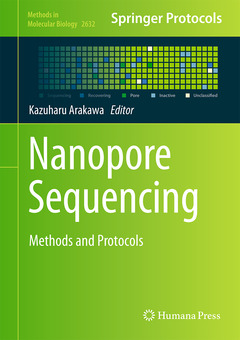Description
Nanopore Sequencing, 1st ed. 2023
Methods and Protocols
Methods in Molecular Biology Series, Vol. 2632
Coordinator: Arakawa Kazuharu
Language: English
Subject for Nanopore Sequencing:
Publication date: 02-2024
324 p. · 17.8x25.4 cm · Paperback
Publication date: 02-2023
324 p. · 17.8x25.4 cm · Hardback
Description
/li>Contents
/li>Comment
/li>
This volume provides comprehensive dry and wet experiments, methods, and applications on nanopore sequencing. Chapters guide readers through bioinformatic procedures, genome sequencing, analysis of repetitive regions, structural variations, rapid and on-site microbial identification, epidemiology, and transcriptome analysis. Written in the format of the highly successful Methods in Molecular Biology series, each chapter includes an introduction to the topic, lists necessary materials and methods, includes tips on troubleshooting and known pitfalls, and step-by-step, readily reproducible protocols.
Authoritative and cutting-edge, Nanopore Sequencing: Methods and Protocols aims to be comprehensive guide for researchers.
Part I. Nanopore sequencing for genomics and beyond
1. The current state of nanopore sequencing
Jonathan Pugh
2. Hybrid genome assembly of short and long reads in Galaxy
Tazro Ohta and Yuh Shiwa
3. Microbial genome sequencing and assembly using nanopore sequencers, Makoto Taniguchi and Kazuma Uesaka
4. De novo genome assembly of Japanese Black cattle as model of an economically relevant animal
Shinji Sasaki, Yasuhiko Haga, Hiroyuki Wakaguri, Kazumi Abe, and Yutaka Suzuki
5. How to sequence and assemble plant genomes
Ken Naito
6. Detection of DNA modification using nanopore sequencers
Yoshikazu Furuta
7. Ultra-low input genome library preparation for nanopore sequencing with droplet-MDA
Kazuharu Arakawa
8. The method of eliminating the Wolbachia endosymbiont genomes from insect samples prior to long-reads
Keizo Takasuka
9. A nanopore sequencing course for graduate school curriculum
Kazuharu Arakawa
Part II. Analysis of repetitive regions and structural variants
10. A guide to genome sequencing containing ultra-long repetitive regions
Nobuaki Kono
11. Analysis of tandem repeat expansions using long DNA reads
Satomi Mitsuhashi and Martin C Frith
12. Finding rearrangements in nanopore DNA reads with last and dnarrange
Martin C. Frith and Satomi Mitsuhashi
13. Long read whole-genome sequencing using a nanopore sequencer and detection of structural variants in cancer genomes
Yasuhiko Haga, Yoshitaka Sakamoto, Miyuki Arai, Yutaka Suzuki and Ayako Suzuki
Part III. Rapid on-site microbial detection and epidemiology
14. Full-length 16S rRNA gene analysis using long-read nanopore sequencing for rapid identification of bacteria from clinical specimens
Yoshiyuki Matsuo
15.Nanopore sequencing data analysis of 16S rRNA genes using Genome Sync-GSTK system
Kirill Kryukov, Tadashi Imanishi and So Nakagawa
16. Genomic epidemiological analysis of antimicrobial-resistant bacteria with nanopore sequencing
Masato Suzuki, Yusuke Hashimoto, Aki Hirabayashi, Koji Yahara, Mitsunori Yoshida, Hanako Fukano, Yoshihiko Hoshino, Keigo Shibayama, Haruyoshi Tomita
17. Rapid and comprehensive identification of nontuberculous mycobacteria, Yuki Matsumoto and Shota Nakamura
Part IV. Nanopore sequencing for transcriptomics and beyond
18. Long-read single-cell sequencing using scCOLOR-seq
Martin Philpott, Udo Oppermann and Adam P Cribbs
19. Unfolding the Bacterial Transcriptome Landscape using Oxford Nanopore Technology Direct RNA Sequencing
Mohamad Al kadi and Daisuke Okuzaki
20. Nanopore Direct RNA Sequencing of Monosome-and Polysome-bound RNA
Lan Anh Nguyen, Toshifumi Inada, and Josephine Galipon
21. RNA modification detection using nanopore direct RNA sequencing and nanoDoc2
Hiroki Ueda, Bhaskar Dasgupta, Bo-yi Yu
Includes cutting-edge methods and protocols
Provides step-by-step detail essential for reproducible results
Contains key notes and implementation advice from the experts



